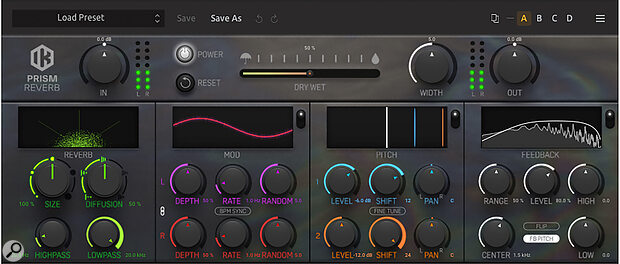Whether added to your T‑Racks 6 Max ecosystem (in which case it’s free) or purchased separately, IK Multimedia’s Prism Reverb is a creative reverb that IK claim goes “beyond shimmer” to deliver “a new dimension of sound”. A bold claim, so let’s see how it stacks up...
4 Processing Modules
Prism comprises four clearly defined, colour‑coded processing modules: Reverb, Mod, Pitch and Feedback, each of which has a bypass switch. Reverb takes care of the initial reverb generation, creating the essential spatial characteristics of the effect, and the reverb size can be anything from short and tight to a very long wash. There are controls here for size, diffusion, low‑pass filter and high‑pass filter, and all values are shown in small print next to the control names. A display above the controls shows the reverb development as a cloud of pixels. At low diffusion settings individual repeats are clearly audible. The decay tail doesn’t have a very natural shape — but as you’ll see below, that changes when we come to the Feedback section.
In the Mod section are two identical sets of controls for the left and right channels, and these can be linked by clicking a chain icon. Here you find pitch modulation with controls for rate and depth, as well as random and tempo‑sync options. A display shows the modulation for each channel in red and purple. Pitch is where you go to create shimmery reverbs or grumbly depths, as there are two individually pannable pitch‑shifters (up to ±24 semitones). A fine tune button allows for more subtle detuning, and a display shows how far the pitches diverge.
Lastly comes the Feedback section I referred to above, with a control for level (amount) and two filter controls: Range and Centre (frequency) that change the shape of a feedback filter, which is displayed above the controls. Additionally there are more conventional high‑ and low‑cut filter controls, and Flip and FB Pitch buttons — FB Pitch takes the pitch‑shifting in or out of the feedback loop, while Flip swaps the stereo channels on each feedback pass, to add spatial depth and complexity.
Sitting above these four modules is a Master section, providing global wet/dry mix, input and output gain with metering, a stereo width control and a bypass/power button. A Reset button sets all parameters to their default positions.
The range of effects on offer is impressive — and the shimmer reverbs are amongst the best I’ve heard.
Effects
While each section has a fairly limited number of controls, the range of effects on offer is impressive — and the shimmer reverbs are amongst the best I’ve heard. Without adding in some Feedback, the reverb decay does sound somewhat unnatural, but once you bring that into play, smoothly decaying, dense reverb tails are in plentiful supply. And if you max out Feedback, the whole system just keeps on recirculating sound indefinitely. The pitch‑shifter allow for the creation of wonderfully lush shimmery effects that sound really smooth — added to a piano it sounds like a string section in the background. The effect on clean guitar is equally magical. IK say that Prism is more than a shimmer reverb, and that is certainly true, but for me its shimmer‑tinted reverbs are what it does best.
I haven’t heard a more mellifluous shimmer since the Strymon Cloudburst, the plug‑in version of which is also reviewed in this issue. Although Cloudburst works in a very different way, Prism manages to deliver that very same sense of smoothness. As with most long, shimmery reverbs, ambient composers, bands who stare at their footwear and those working on sound for picture will probably be the core users. But anyone who’s into the more experimental side of pop could get a lot of out of Prism too.
Information
€99.99 including VAT. Free for owners of T‑Racks 6 Max.
$99.99 (Free for owners of T‑Racks 6 Max).

